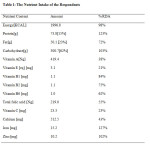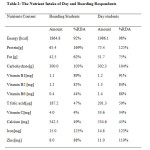Introduction
Adolescent is defined by WHO as a person between 10-19 years of age. Adolescence involves: Rapid physical growth and development; Physical, social and psychological maturity. The start of behaviours that may become life-time habits that results in diseases many years later.1 Adolescence is the period of transition from childhood to adulthood with accelerated physical, biochemical and emotional development. It is during this period that growth spurt occurs.2 Growth velocity is maximum for boys between 12 – 15 years of age and for girls, 10 – 13 years, commonly known as the younger adolescence and 15–19, which are referred to as the older adolescence.3
In this period of accelerated growth, the demand for nutrients increases posing a greater risk of nutritional deficiencies. Hence, there is an increase in morbidity and mortality rate due to infections, particularly, adolescents residing in developing countries.4 Therefore, it is important that nutrition is adequately adjusted to their needs becausechildren and adolescent populations are very sensitive to inadequate nutrition.5
The adolescents constitute the special group that are usually involved in mental process of learning and understanding and it is the stage when they develop food choices and food habits. Consumption pattern of adolescence is such that they often obtain one – fourth to one – third of all their energy and major nutrients from snacks. Unfortunately, recent studies find what you might expect – that adolescents snacks mostly on potato and corn chips, cookies, candies, and ice cream. Key reasons for snacking include an opportunity to get out and socialize with friends.6
There is therefore need to assess their nutritional status and dietary pattern in other to help produce accurate data that will help in designing programmes that will help improve their nutritional status.
Subjects and Method
The study was carried out among both male and female students attending day and boarding secondary schools in Owo municipal. A total of 200 students were systematically selected from four randomly selected secondary schools of which two were secondary schools with boarding facilities and the other two schools were without boarding facilities for students. The dietary assessment was carried out using 24 hours dietary recall. The full and appropriate description of all food eaten including drinks were recorded and converted to nutrients using nutritional survey (Nutri – Survey) software (2007 version). The intakes was compared with the recommended dietary allowance (RDA).
Results
The comparative study of the nutrient intake of adolescent student in barding and day schools was carried out and analyzed. The nutrient intake of the respondent as shown in the table 1 revealed that the intake of the energy was 98% of RDA while that of protein was above RDA (123%). However, vitamin E, B6, folic acid and vitamin C were found to be lower than RDA as intakes were 21%, 62% 55% and 23% respectively .Also mineral intake shows that there is low consumption of calcium (43%) while iron intake exceeded RDA (127%).
 |
Table 1: The Nutrient Intake of the Respondent Click here to View table |
Table 2, compared the nutrient intake of the respondents .The result showed that among the schools studied,energy intake was found to be adequate ,while protein intake among both boarding and day students exceeded the RDA as intake were 169% for boarding students and 125% for day students.Also, the vitamin B6 intake of day students was almost optimumwhile the intake of boarding students was extremely low (44%), and the same goes for folic acid of which intake was low for both boarding (47%) and day (50%) students.. Among all the vitamin intakes ,vitamin C intake was shown to be the lowest vitamin consumed so far as intake was 34% for day student and 4%for boarding student and this is extremely below the RDA.
 |
Table 2: The Nutrient Intake of Day and Boarding Respondents |
Discussion
The intake of the respondents revealed that the intake of energy was 98% of the RDA. This agrees with Anyika et al., (2009),7 Duchi and Webb (2004)8 who reported that the energy intake was optimum and slightly higher than RDA in all the schools studied, however, this study disagrees with Ijarotimi (2004)9 in the study conducted among adolescents who reported that none of the subjects was able to meet energy requirements. There was no significant difference in the energy intake of the day and boarding students. This may suggest that the boarding students were adequately fed by the school. The mean protein intake was above the RDA (123%) and this might be due to the fact that most students consumed more proteinous foods like beans, which brought about the increase in the mean intake of protein.
However, vitamins E, B6, Folic acid and vitamin C were found to be lower than RDA as intakes were 21%, 62%, 55%, and 23% respectively. Also calcium intake was low (43%), as against the daily requirement of calcium for adolescents but the students consumed 512.5mg. The findings agreed with the other findings, which established that besides protein and energy malnutrition, deficiencies of micronutrients are more pronounced among the pregnant women, young children and adolescents in developing countries.9,4 ,10
Finally, the comparative study of the nutrient intake of the respondents was shown in the study and the result shows that in the schools, energy intake was found to be adequate, while protein intake among both boarding and day students exceeded the RDA as intakes were 169% for boarders and 125% for day students. This is a result of the high consumption of body building foods basically of plant origin this is in agreement with Ijarotimi (2003)(9) who stated that in developing countries, vegetable sources such as tofu and other soy foods, beans and nuts are the major sources of protein. In vitamin consumption, vitamin C intake was the lowest however; the day students consumed more vitamin C (34%) than the boarding students (4%). The low intake of vitamin C among the boarding students is because they were not served fruits in the school meals. Vitamin C is very important during adolescence; it is an antioxidant that helps in wound healing and helps in preventing bleeding from capillaries and also prevents scurvy. Therefore school proprietors and Vendors should improve access to low cost healthy local foods especially fruits (i.e. banana, pawpaw, pineapple, oranges, pears, carrots, maize combs, eggs, homemade yoghurt, enriched gruel with fruits and groundnuts) and decrease access to junk food in schools.
Acknowledgements
The authors are grateful to the head of department of Nutrition and dietetics of Rufus Giwa polytechnic, Owo and to the principals of schools used for this study. Also, we sincerely appreciate the research assistant, Nifemi for making this work asuccess.
References
- World Health Organization.Physical status: The use and interpretation of anthropometry. Technical report series. Geneva. Report No. 854(1995).
- Lytle L. A. Nutritional issues for adolescents. JAM Diet Assoc. 2002; 102 (3 SUPPL): S8-S12(2002).
- Luder E and Bonforte R. J. Health and Nutritional issues during Childhood years topic in clinical nutrition 11(3): 47(1996).
- Bhaskaram, P. Immunobioogy and mild micronutrient deficiencies. British Journal of Nutrition, 85,pp S75-S80 (2001).
CrossRef - E. N. Whitney, S. R. Rolfes: Undestanding Nutrition, An International Thomson Publishing Co., Belmont, CA. pp. 181– 522(1999).
- Story M and Cory Slechta. Adolescent Nutrition: current trends and critical issues. Topic in clinical nutrition 11(3): 56, (1996).
- Anyika J. U., Uwaegbute, A. C., Olojede, A. O.Nwamara J. U. Nutrient Intakes of Adolescent Girls in Secondary Schools andUniversities in Abia State of Nigeria. Pakistan Journal of Nutrition 8 (10): 1596-1602(2009).
CrossRef - Dushi Irena and Webb Anthony. Household Annuitization Decisions: Simulation and Empirical Analyses. Journal of Pension Economy and finance (3) 109-143(2004).
- Ljarotimi O. S., Eleyinmi A F, and Ifesan, OT. Evaluation of nutritional status ofadolescents in institutionalized secondary schools in Akure, Nigeria J.of food, agriculture & environment. I (3&4):64-68(2003).
- Maharaj K. B. Bhandari N. Management of Severely Malnourished Child; perspective from developing Countries. BMJ 326:146(2003).
CrossRef.

This work is licensed under a Creative Commons Attribution 4.0 International License.




